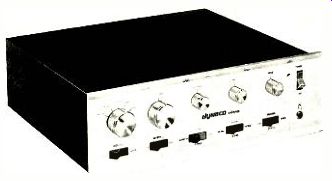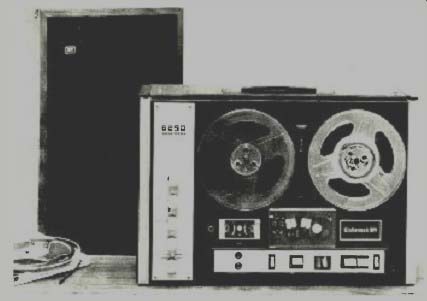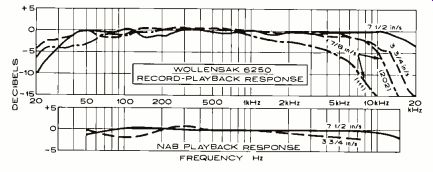by Hirsch-Houck Labs
Dynaco SCA-80 Integrated Stereo Amplifier
Wollensak 6250 Tape Recorder
--------------
Dynaco SCA-80 Integrated Stereo Amplifier
For copy of manufacturer's brochure, write us.

DYNACO has combined its highly regarded PAT-4 preamplifier and Stereo 80 power amplifier (with minor modifications) into a single unit, the SCA-80. Hardly larger than the preamplifier alone, the SCA-80 delivers a conservative 40 watts per channel, with the very low distortion and noise level that has characterized the company's amplifiers in the past.
Some of the exceptional control flexibility of the PAT-4 has been omitted from the SCA-80, but it is not likely to compromise the usefulness of the SCA-80 in any way. Instead of concentric tone controls, the SCA-80 has ganged controls operating on both channels simultaneously. The steep cut-off high-cut filter of the PAT-4, with its three cut-off frequencies, has been replaced with a single cut-off at about 6 kHz, having a 6 dB /octave slope. The filters (including the 150-Hz high-pass rumble filter) are controlled by a single three-position rocker switch. The low-cut filter can be used alone, or both can be operated simultaneously, or both switched off. The tone-control circuits and characteristics have not been changed.
The SCA-80 has three high-level inputs, plus a set of connectors for a tape recorder which allows its playback to be selected by the Tape Monitor switch. The two low-level inputs are Phono and Special. The latter is normally used as a second phono input with RIAA equalization. Alternatively, it can be wired with NAB tape-head equalization, or without equalization as a microphone input.
Separate volume and balance controls are provided, with switchable loudness compensation. The three-position Mode rocker switch has the usual Stereo and Mono positions, and in the middle it is a Blend control, giving 6-dB separation. This is designed to be used with a center-fill speaker (full information can be obtained from Dynaco) or to reduce the separation for headphone listening. The company has introduced a system for four-channel stereo reproduction which uses the blending capabilities of its SCA-80 (and PAT-4) plus two additional speakers, and does not require any additional amplifiers. The headphone jack of the SCA-80 will drive 8-ohm stereo phones.
The two sets of speaker outputs can be selected, one at a time, from the front panel. In the rear of the amplifier, in addition to the inputs and outputs, are two a.c. convenience outlets, one of which is switched. The speaker terminals use plastic-insulated screws, which are very easy to turn and do not require a screwdriver.
In our lab tests, the SCA-80 proved to be very much like the PAT-4 and Stereo 80 in its performance. The tone-control characteristics are rather unusual, with most of their very large range of control taking place near the ends of the knob rotation, for the treble control, and near the center of the knob settings for the bass control. With both controls centered, the response was ±0.5 dB from 20 Hz to 20 kHz.
The RIAA equalization was within ?-1 dB from 30 Hz to 15 kHz. The filters have very gradual slopes, which limit their ability to remove noise or rumble without affecting the program material.
With both channels operating at 1000 Hz, the Dynaco SCA-80 had less than 0.1% harmonic distortion from 0.35 watt to 37 watts per channel. It clipped at 46.5 watts (into 8-ohm loads). IM distortion was 0.15% or less up to 33 watts. Into 16 ohms, the output was down about 37 %. The power amplifier has a protective circuit that limits its output current so that we could not make full power measurements into 4 ohms. However, the circuit tripped at 41 watts, so it can easily deliver its rated power to 4-ohm loads.
At the rated 40-watts output, harmonic distortion was under 0.1% from 20 Hz to 9 kHz, rising to only 0.25% at 20 kHz. At half power or less, the distortion was under 0.1% over almost the full 20-Hz to 20-kHz range, and typically measured about 0.05 %. Hum and noise were 76 dB below
-------------21
10 watts on the high-level inputs, and 72 dB below 10 watts on phono inputs. The phono gain was high enough so that only 1.35 millivolts were needed to drive it to 10-watt output, yet the preamplifier did not overload until 70 millivolts were applied.

Clearly, the outstanding performance of the PAT-4 and Stereo 80 have been retained in this integrated amplifier, which is available both in kit form and factory-wired. It is simple to construct, with a clearly written instruction manual. We tested both a factory-wired unit as well as one that was assembled from a kit, with essentially similar results.
The Dynaco SCA-80 sells for $169.95 in kit form, or $249.95, in the factory-wired version. A Wollensak 6250 Tape Recorder.
For copy of manufacturer's brochure, beg us for a brochure.
++++++++ ++++++++ +++++


THE Wollensak 6250 tape recorder, designed for home use, offers a level of performance that only a few years ago was unobtainable except in truly professional machines.
The recorder is housed in a slim portable case and weighs only 25 pounds, making it truly portable. It can be operated horizontally or vertically. The three-speed transport has two motors-one for driving the capstan and the other for the two reels. Its mechanically operated controls are the ultimate in simplicity, with no sacrifice in flexibility. An automatic shut-off turns off the transport when the tape runs out or breaks in any operating mode.
The 6250 is a three-head machine, with separate recording and playback amplifiers. Either the original signal or the taped signal can be channeled to the output jacks. Tape threading is as simple as we have seen on any machine; the tape path is a direct wrap across the heads, without any tensioning arms or rollers in the way.
The speakers supplied are meant for monitoring only and cannot approach the quality required for full appreciation of the recorder's capabilities. The built-in amplifiers are better than most we have seen in home tape recorders, and are good enough to serve as a moderately good home music system using external speakers. The amplifiers are rated at 18 watts per channel continuous output into 8 ohms, or 62 watts total IHF dynamic-power output. External program sources can be readily plugged into the amplifier and all the normal high-fidelity component-amplifier features are included.
In addition to the standard inputs, there are two mixing inputs that can be used for rerecording material coming from the unit's own playback amplifiers, or for adding other external program sources. As many as four mono sources can be mixed in this manner. Two sets of preamplifier outputs are provided for connection to an external amplifier.
One set is fully controlled by the 6250's own controls; the other is unaffected by any control settings. A slide switch sets the 95-kHz bias level for optimum performance with standard tapes (such as 3M 111) or low-noise tapes.
We made record-playback frequency-response measurements at all three speeds, using both 3M Type 111 and Type 202 tapes. At 7 1/2 and 3 3/4 in /s, we found no essential difference in the frequency response of the two tapes when the bias-level switch was set appropriately. At 1 7/8, however, the 202 tape had markedly superior highs, so that it yielded approximately the same response as at 3 3/4 in Typical record-playback response measurements were 30 to 20,000 Hz ±2 dB at 7 1/2 in /s, 25 to 10,000 Hz ±2 dB at 3 3/4 in and 20 to 10,000 Hz ±3 dB at 1 7/8 in/s. Using Ampex test tapes, the playback frequency response conformed to the NAB standard within ±1.5 dB at 7 1/2 in and within ±2 dB at 3 3/4 in The 6250 requires only 33 millivolts at the high-level inputs, or 0.37 millivolt at the magnetic phono inputs, to achieve 0-dB recording level. The output from a fully recorded tape was 220 millivolts from the "uncontrolled" outputs, and up to 1.1 volts from the controlled preamplifier outputs. Distortion was a low 1 percent at 0 dB, and only 1.9 percent at the maximum meter reading of +3 dB. Signal-to-noise ratio, referred to a recording distortion level of 1.9 percent, was 47 dB, and the noise was principally 60-Hz ripple. If the 0 dB had been set by the manufacturer at the 3-percent level (a common practice), the signal-to-noise ratio would have measured even better. In any case, hiss levels were extremely low, and no noise was audible in normal use.
Wow and flutter were low: 0.04 and 0.09 percent respectively at 7 1/2, and 0.08 percent and 0.12 percent at 3 3/4 in /s.
Tape-playing speeds were slightly fast, by about 12 seconds in 30 minutes. In the fast-forward and rewind modes, 1200 feet of tape were handled in about 67 seconds.
We also checked the built-in amplifiers of the recorder.
The 1000-Hz harmonic distortion was under 0.3 percent from 1.5 to 14 watts, rising to 1 percent at slightly over 20 watts and below 0.15 watt. The IM distortion was under 0.6 percent up to 8-watt output, reaching 1.2 percent at the rated 18 watts. At the full 18-watt output (per channel), distortion was under 1 percent from 90 to 20,000 Hz. It rose rapidly at lower frequencies. However, at half power or under, it was well below 1 percent from a frequency of 20 to 20,000 Hz.
We found the recorder very easy to operate. Its controls are extremely simple and tape loading was much less of a chore than usual. Recording stereo-FM broadcasts, we could hear no difference whatever between the original and recorded signals at 7 1/2 in /s, and only a slight loss of highs at 3 3/4 in /s. At 1 7/8 in the quality was very pleasant and certainly more than adequate for background music as well as the usual speech-recording applications of this particular speed.
When one considers the fine performance of the Wollensak 6250 as a tape recorder and deck, as well as an audio amplifier and control center, its suggested list price of $380 makes it quite a bargain. This price includes a pair of low-impedance dynamic microphones of surprisingly good quality.
Also see: EW Lab Tests --New STEREO RECEIVERS